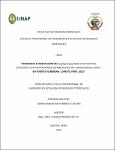Incidencia e infestación de Hypsipyla grandella con control etológico en plantaciones establecidas de Cedrela odorata “cedro”. en Puerto Almendra, Loreto, Perú. 2022
Abstract
The limiting pest for cedar and mahogany cultivation in Latin America and the Caribbean is undoubtedly the moth Hypsipyla grandella. "shoot borer” Several control methods were applied, but the use of physical and ethological control using barriers and intelligent solar lights were not evaluated despite their good potential in the ethological control of agricultural pests. The objective of the project was to determine if ethological control (applying white and yellow artificial lights) decrease the incidence and infestation of Hypsipyla grandella in clonal gardens and plantations of Cedrela odorata "cedro". The study was developed in the Fundo Almendra of the Faculty of Forestry Sciences of the UNAP, which has a plantation of "cedar" with a high incidence of H. grandella, all the larvae of H. grandella were removed and fumigated throughout the plantation, then in two plots were installed 6 poles 4 m high with intelligent solar lights (white and yellow) that were turned on from 6 pm to 6am, in the control plot no lights were installed. The number of infested plants, the number of damaged shoots and the number of larvae/shoots were recorded biweekly for 10 months. The results indicate that the incidence of H. grandella was lower in the lights with respect to the control, which achieved 100% damage. In infestation, the groups exposed to white light and yellow light exhibited lower infestation and shoot damage compared to the control group. These results indicate that LED light acts as a repellent effect and reduces the presence of H. grandella in C. odorata plants, making it a promising technique for the control of this pest in the Peruvian Amazon. La plaga limitante para el cultivo del cedro y la caoba en América Latina y el Caribe es sin duda la polilla Hypsipyla grandella “barrenador de los brotes”. Varios métodos de control fueron aplicados, el uso del control físico y etológico usando barreras y luces solares inteligentes a un no fueron evaluados a pesar de su buen potencial en el control etológico de plagas agrícolas. El objetivo del proyecto fue determinar si el control etológico (aplicando luces artificiales de color blanco y amarillo) disminuyen la incidencia e infestación de Hypsipyla grandella en Jardines clonales y plantaciones de Cedrela odorata “cedro”. El estudio se desarrolló en el Fundo almendra de la Facultad de Ciencias forestales de la UNAP, que cuenta con una plantación de “cedro” con una alta incidencia de Hypsipyla grandella se retiraron todas las larvas de Hypsipyla grandella y se fumigaron en toda la plantación, luego en dos parcelas se instalaron 6 postes de 4 m de altura con luces solares inteligentes (blanca y amarilla) que se encendían de 6 pm a 6am, en la parcela testigo no se instalaron luces. Quincenalmente durante 10 meses, se registraron el numero de plantas infestadas, el número de brotes dañados y el número de larvas/brote. Los resultados indican que la incidencia de H. grandella fue menor en las luces respecto al testigo que alcanzo 100% de daños. En la infestación los grupos expuestos a luz blanca y luz amarilla exhibieron menor infestación y daño en los brotes en comparación con el grupo de control. Estos resultados indican que la luz LED actúa como un efecto de repelencia y reduce la presencia de H. grandella en las plantas de Cedrela odorata constituyéndose en una técnica promisoria para el control de esta plaga en la amazonia del Perú.
Collections
- Tesis [407]


